
views
X
Research source
it won’t be long before the kittens start to mature. It will be important for you to identify which kittens are male and which ones are female before they reach sexual maturity (around 5 weeks of age).[2]
X
Research source
Determining the Sex of a Baby Rat

Wait until the kittens are about two weeks old. Although it is possible to tell the difference between male and female kittens as soon as a few days after birth, handling them this soon after they are born can be very stressful to them. If there is no immediate urgency for you to determine the sex, wait for a few weeks before handling them. At two weeks of age, the kittens will open their eyes and can start eating solid food.
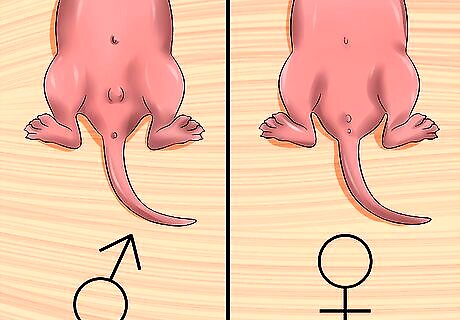
Look at the distance between the anus and urethra. When the kittens are about two weeks old, gently lift them out of the cage and place them on their backs in the palm of one of your hands. Identify the anus (under the tail) and urethra (small opening a little further up towards the belly). The distance between these two body parts (‘anogenital distance’) will be 1.5 to 2 times longer in male rats than female rats. The male kittens’ testicles will eventually descend between the anus and urethra. Be mindful that kittens typically do not like to stay still for long. It may take a few tries before any of them stay still long enough for you to determine what sex they are. In addition, the mother rat may not be comfortable with you handling her babies. If the mother looks upset when you try to handle the kittens, try again later. Hold two kittens in your hand at one time so you can compare the anogenital distances.
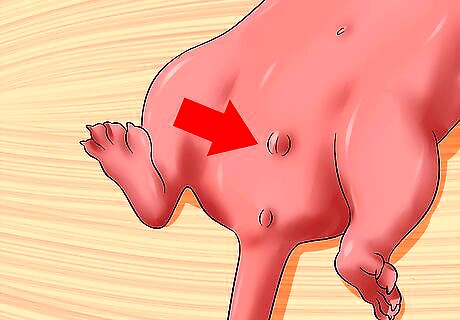
Check for testicles near the tail. As male rats reach sexual maturity, they will develop a large, visible scrotum that contains the testicles. However, the testicles can sometimes retract upward into a male rat’s abdomen, so you may not be able to see them. The scrotum and testicles should be visible on male kittens between three to four weeks of age. Since the testicles can retract, they are not always a surefire way to differentiate between a male and female kitten. If you do not see testicles, use the anogenital distance and presence/absence of nipples to make the sex determination. EXPERT TIP Brian Starr Brian Starr Rat Specialist & Breeder Brian Starr is a Rat Specialist and Breeder and the Owner of OC Dumbos out of Central Florida. As America’s only breeder of pet Roof Rats, Brian and OC Dumbos specialize in rat breeding, training, and care. Years of experience and several generations of careful breeding have allowed Brian and OC Dumbos to create a line of tame Roof Rats, bred to make friendly, fun pets. In addition to offering rat accessories and training resources, OC Dumbos also offers free Roof Rat adoptions. Brian Starr Brian Starr Rat Specialist & Breeder Check genital spacing to identify a baby rat's sex. At 5 weeks old, gently check visible genital spacing to safely determine apparent biological sex; males have larger gaps between organs, while females have shorter spans between them. Handle gently to prevent causing your rat any stress.
Knowing What to Do After Determining the Sex

Separate the males from the females. When rats reach sexual maturity, they can become prolific breeders. One female rat can produce 6 to 12 litters per year, with each litter containing an average of 12 kittens—that’s a lot of rats! To prevent unwanted pregnancies, remove the male kittens from the cage when they are around three weeks old. The female kittens can stay with their mother until you adopt them out. The male kittens must be moved to a new cage because they will try to mate with their female littermates and mother.
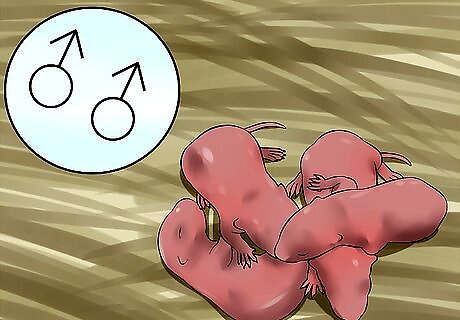
Keep same-sex littermates together. Even after separating the sexes, you should house same-sex littermates in the same cage until they are six weeks old. This will help them continue their emotional development and help them get ready for being adopted. After determining the sex of each kitten, handle them on a daily basis to get them more comfortable with humans. As the kittens get larger, pick them up by gently placing one hand behind their front legs. When you lift the kitten in the air, place your other hand around its back end for additional support.

Find homes for the kittens. When the kittens are old enough to be adopted out, you should start looking for someone to take them. It is not advisable to take them to a pet store, since they will likely become food for the snakes. Even taking the kittens to an animal shelter may not be the best idea, since the shelter may not have the facilities to care properly for the kittens and subsequently euthanize them. Your best bet may be to put the word out in your local community that you have baby rats that are ready for adoption. When potential new owners contact you, ask them questions to make sure they are ready to make the commitment to give your baby rats the care and love they deserve. For example, ask them if they have ever owned rats before. If they have not, ask them if they have read up on how to care for rats. Trust your gut when selecting someone to adopt your baby rats. You want them to go to a good home, so you should have a good feeling about the person who wants to adopt them. Make sure you charge an adoption fee. It does not have to be a lot, but chances are the new ‘rat’ parent will care about the baby rats more if you do not give them to him or her for free.
Spaying or Neutering Your Rat
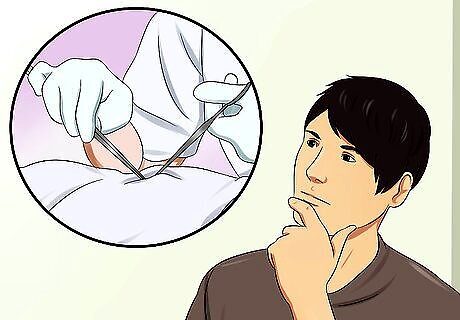
Decide if you should spay or neuter your rat. Spaying a female rat involves taking out her ovaries and uterus. For males, neutering involves removing the testicles. Spaying, or desexing, is not a commonly-performed surgery in rats. Many rat owners decide to simply keep rats in groups of the same gender, rather than put their rats through surgery. However, if you plan to house your male and female rats together, you must have them spayed or neutered to prevent unwanted pregnancies. A rat should be spayed or neutered at around three months of age. Spaying a female rat comes with several benefits, including a decreased chance of developing several types of tumors (breast, uterine, pituitary), and the prevention of pyometra (bacterial infection of the uterus). An intact female will go into heat every few days and become quite grumpy and agitated. Spaying her can make her a little more pleasant to be around. For male rats, neutering decreases aggressive behavior and can make their coats less coarse. Deciding to spay or neuter should be done on an individual basis, since all rats are different. If you are unsure what would be best for your male and female rats, discussing spaying and neutering with your veterinarian.

Identify an experienced exotic veterinarian. Not all veterinarians have extensive experience with rats, particularly when it comes to performing surgery. If your own veterinarian is not an exotic expert, ask him or her to recommend other local exotic veterinarians. Having an exotic veterinarian who is experienced with performing rat surgeries increases the likelihood of your rat having a successful surgery. Once you have identified an exotic veterinarian, schedule an appointment with him or her. The veterinarian will examine your rat and make sure he or she is healthy enough for surgery. If your rat has a treatable illness, the veterinarian will make sure the illness is fully treated before performing surgery. Discuss the cost of a spay or neuter with the veterinarian. The exact cost will vary from one veterinary clinic to another.
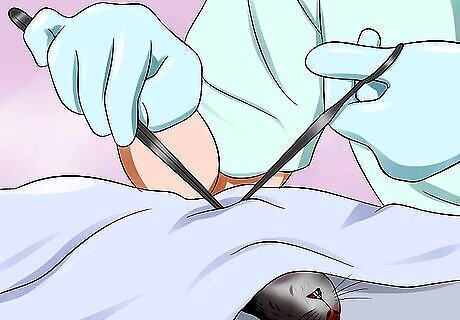
Take your rat to get spayed or neutered. If you have made the decision to spay or neuter your rat, and he or she is healthy enough for surgery, schedule the procedure with the exotic veterinarian. Fortunately, since rats cannot vomit, you do not have to fast your rat before surgery. Whether your rat is getting spayed or neutered, the veterinarian will give your rat an antibiotic injection to prevent infection at the surgical site. To control pain, the veterinarian may also give your rat some pre-surgical pain medication. Your rat will be anesthetized for the surgery. The veterinarian will keep your rat warm during and after surgery to prevent your rat from developing hypothermia. Since rats are small, they could lose body heat quickly during surgery. At the end of surgery, the veterinarian will use suture that will dissolve on its own in a few weeks, meaning that you will not need to take your rat back to the veterinarian to have suture or staples taken out.

Observe your rat for signs of pain. A rat spay or neuter is an outpatient surgery, so you will be able to take your rat home the day of surgery. When you bring your rat home, you will need to keep a close eye on him or her to ensure a smooth recovery. For example, watch for signs of pain in your rat, including hunching over, not eating or drinking, and looking withdrawn. Despite being a little woozy and lethargic after surgery, your rat should be able to resume normal activities. However, pain could prevent your rat from doing so. If the veterinarian did not already prescribe pain medication for your rat, contact him or her for a prescription. Administer the medication as prescribed. In the first day or two after surgery, it may help to keep your rat separated from the other rats until he or she is up and moving around a little better.

Monitor your rat’s incision site. It is important for you to check for bleeding at your rat’s incision site. An easy way to do this is to put some white paper towel in his cage and check it periodically for spots of blood. If your rat has cage mates, you will need to keep a close watch on them to make sure they are not bothering the incision site and causing it to bleed. The cage bedding may also show spots of blood. Change the bedding frequently to reduce the chance of the incision site becoming infected from dirty bedding. Your rat may start to bother his incision site, which could cause it to bleed more and become susceptible to infection. If the incision site is starting to look infected (e.g., swelling, yellow discharge), take your rat to your veterinarian for treatment.




















Comments
0 comment